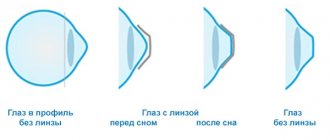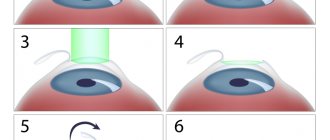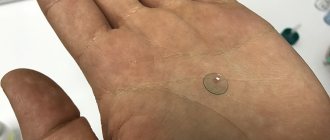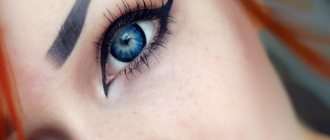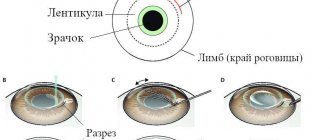This type of lens is also used for decorative purposes - for filming in films or to create a shocking image.
What are scleral lenses
The first scleral contact lenses were invented at the end of the century before last, but then they were a terribly uncomfortable thing: oxygen was not allowed through, the material was hard, and therefore they were temporarily forgotten.
A century later, when scientific progress flew into space, lenses were created that completely covered the entire sclera, that is, the white of the eye, to solve the problem of keratoconus. Later they began to be adapted to treat many other eye ailments. Such accessories came to cinema only in the 1990s, and then they reached cosplayers and other lovers of interesting images.
What do they treat?
First of all, this is a therapeutic device. Its range of applications is quite large:
- Keratoconus. With this disease, the cornea becomes like a cone extended forward. Sometimes, however, there is also posterior keratoconus, also known as Butler's syndrome. Correction using a scleral lens in this case is carried out due to the fact that it straightens the cornea mechanically and due to the presence of tear fluid;
- sensitivity to light (due to eye injuries and diseases);
- dry eye syndrome;
- with ectasia of the cornea of the eye;
- with microophthalmia;
- absence of the iris of the eye (aniridia);
- with Stevens-Johnson syndrome (corneal growth);
- neurotrophic keratitis;
- Sjogren's syndrome (expressed in dry eyes, burning, sand in the eyes, pain);
- aberration of the eye;
- eye injuries;
- for problems after eye surgery;
- deformation of corneal implants;
- complications after keratoplasty;
- eye burns (thermal and chemical);
- problems after laser correction.
Scleral lenses are also used if the eyes are too sensitive to normal ones and in the treatment of astigmatism.
Scleral lenses are also used in ophthalmic experiments aimed, for example, at tracking eye movements (needed in studies in psychology, in studies of the visual system and in linguistic studies). For this purpose, lenses with built-in mirrors are most often used.
Who are scleral lenses recommended for?
Scleral lenses are designed specifically for those patients for whom, due to the characteristics of the cornea, it is impossible to choose glasses or soft contact lenses. Indications include:
- keratoconus, keratoglobus;
- high myopia and hypermetropia;
- high degree astigmatism;
- conditions after operations: cross-linking, keratotomy, corneal transplantation, laser vision correction, implantation of corneal rings;
- scars on the cornea;
- chronic inflammatory processes;
- limbal stem cell deficiency;
- pellucid marginal degeneration;
- severe dry eye syndrome.
Advantages and disadvantages
The main advantage of scleral lenses is the material from which they are made. Most often this is polymacon. This material is quite strong, but at the same time elastic, has through pores, is durable and safe. There are other strengths:
- Due to the elasticity of the material, scleral lenses can be worn continuously for several days in a row. The material does not damage the cornea and sclera of the eyes;
- Through pores in the material. Scleral lenses provide excellent oxygen transmission to the eye. Thanks to this, the eye is ventilated and it is possible to get rid of corneal edema. This is more difficult with other types of lenses;
- the material is durable and rigid. This makes it easier to care for the lenses and protects them from mechanical damage, whether from falling or deformation. Scleral contact lenses can be worn for several years in a row;
- scleral lenses are safe for health;
- The size and shape of scleral lenses can be changed without compromising their effectiveness.
Scleral lenses also have disadvantages. So, this thing is very expensive: for one pair you will have to pay from 3 thousand rubles. In addition, they can hardly be found in a pharmacy. Most often, they are either made individually, to suit your eye shape and sclera, or they take a long time to select and adjust. This process is very long and not very pleasant.
How to choose scleral lenses
First of all, it is important to understand that choosing lenses of this type is very difficult. Secondly, be prepared for the fact that cheap scleral lenses from China can provoke many problems, including corneal hypoxia, swelling, and vascular ingrowth. In addition, factory lenses are dangerous because they can slip off and damage your eyes. So, it’s better to do such a problematic thing exclusively to order. Production can last up to a third of the year and consists of the following stages:
- Measuring the parameters of your cornea;
- Creation of a set of scleral lenses, which will then be adjusted to suit your eyes (prototype);
- Approbation. You wear the lenses for several weeks under the supervision of a doctor, who makes adjustments;
- Final fitting. If the lenses are therapeutic, they remain transparent, but if you ordered white scleral lenses, black or red, then they are now colored.
There is one more important point. Black scleral lenses come in several types.
- Firstly, they can be 20-24 mm in diameter. These cover the entire sclera and make it completely black;
- Up to 1.8 cm in diameter. Thanks to this, the cornea turns out to be contrasting;
- Diameter 13-15 mm. These are called semiscleral.
If it is not possible to order scleral lenses, do not order them online, but consult an eye doctor. Let him determine the parameters of your eye, sclera and cornea. And be sure to show the optometrist the selected lenses. And yet, scleral lenses, as an accessory, are made for actors only to order and according to their parameters.
By the way, even correctly selected lenses can cause discomfort. Wear and wear them correctly.
What it is
Scleral lenses, unlike conventional corneal contact correction devices, have a diameter of 14 to 24 mm. They have this name because they completely cover the cornea (the transparent front layer of the eye) and rest on the white membrane (sclera) of the eye.
There are 3 types depending on the size and direct area of contact with the surface of the eyeball:
- Corneoscleral and semiscleral - have a slightly larger diameter compared to corneal ones (13-15 mm) and are based on the transition area between the cornea and sclera (limb);
- Mini-scleral - cover the entire surface of the cornea and touch the front part of the white membrane of the eye. They have a diameter of up to 18 mm;
- Covering the entire cornea - they have the largest diameter (20-24 mm) and, accordingly, the largest area of coverage of the eye.
All modern scleral correction devices are made of a special material – polymacone, which has high oxygen permeability. This allows you to avoid unpleasant consequences (for example, corneal edema) and makes wearing them very comfortable. Products made from this material are more rigid, which avoids their deformation.
REFERENCE: The higher the gas permeability of products, the safer they are to use.
How to put them on
If the lenses are made correctly and fit perfectly, you can put them on in literally a third of a minute. But there are several important points.
First of all, be sure to teach how to distinguish the “wrong side” of a scleral lens from its “face.” Otherwise, either you won’t be able to wear anything, or it will hurt unbearably. It’s correct if its base is convex, and it itself looks like a bowl with the edges looking up. If the accessory is turned the “wrong” side, it looks more like a saucer with a flat bottom, which has smooth edges;
You need to put them on only after your eye makeup is completely done. Otherwise, there is a risk that cosmetics will get into your eyes and cause irritation. It is especially unpleasant if glitter or mascara gets under the back of the scleral (or any other) lens. The next day you are guaranteed reddened and swollen eyes;
Anyone who wears any lenses should look for a painted eye on their decorative cosmetics. This is confirmation that such cosmetics will not damage the lens;
It is best to put them on and take them off in front of a comfortable magnifying cosmetic mirror, and while sitting. If your nails are too long and sharp, do this with extreme caution;
You can drip special drops before putting it on;
Before putting it on, be sure to wash your hands with a bactericidal detergent. After this, it is better to wipe them with a paper napkin rather than a towel, so that not a single lint remains on the skin. Hands must be perfectly dry. If it is not possible to wash your hands, treat them with a bactericidal wipe and disinfectant. Just wet ones won't do anything.
The mechanism and algorithm for putting them on is as follows:
- We remove the lens itself from the container and place it face up on the pad of the index finger;
- Pull the lower eyelid down as far as possible using the thumb of the hand in which the lens is on the finger;
- Raise the upper eyelid with the index finger of the other hand;
- We lower the accessory onto the surface of the sclera so that the edges lie directly along the lines of the drawn eyelid. We lower our eyelids slowly and move the lens. If this works and there is no discomfort, everything is done correctly.
Colored accessories
Manufacturers of ophthalmic accessories offer a wide range of scleral lenses with patterns. They allow you to create a truly shocking image. Particularly popular are black models, which are responsible for the demonic appearance. The fashion for these came after the abundance of horror films about the dead on the screen. Bright makeup will increase the intimidating effect.
Lenses covering the entire eye are in demand, creating an imitation of blood or fire. The accessory is in demand among young people at themed parties. Young people also often choose all-white lenses. They overlap the iris and merge with the sclera. The view becomes very mysterious.
Expert opinion
Nosova Yulia Vladimirovna
Ophthalmologist of the highest category. Candidate of Medical Sciences.
How to remove them
The algorithm for removing a scleral lens is even simpler than for putting it on. It all starts again with thoroughly cleaning your hands. Now with your left hand (more precisely, with your index finger), we pull back the lower eyelid as much as possible and release the lens from below. Using the index finger and thumb of the other hand, we grab the lens from below and carefully pull it down. It is important not to change its position. Let her move down the eyelid on her own. All that remains is to return it back to the container. You can shake the container a little. This will help clean the lens.
How to choose the right product
The selection is carried out using high-precision equipment. The anatomical features of the eye structure must be taken into account. The doctor measures visual acuity and performs optical coherence tomography of the cornea. Lens fit is calculated using a special formula. The entire procedure takes at least 3 hours.
Expert opinion
Kim Oksana Alexandrovna
Head of the ophthalmology clinic. Ophthalmologist with more than 10 years of experience.
Scleral lenses are made to order. You can receive a ready-made pair approximately a week after the examination. It is advisable to put it on for the first time in the optics: if necessary, the specialist will immediately correct the shape. The adaptation period does not go smoothly for everyone. The addiction process often takes place under the supervision of an ophthalmologist. Additional adjustments may be prescribed to achieve an optimal fit.
The service life of the product largely depends on the type of dye chosen, as well as on the raw materials. Maximum service life is 5 years. Sometimes trial lenses may be issued for the first weeks: the doctor observes the results and makes changes to the parameters. The prototype must be transparent.
Some rules of wearing and care
Scleral lenses need to be cleaned just like any other. There are special products and tablets for this. Be sure to keep the accessory in saline solution.
To clean them well, you need to fill the containers with distilled water or solution and add a protein tablet. In half a day, you can clean even the deepest layers of the lens in this way.
You can also place lenses and solution in special devices. This way you can clean and disinfect in a third of an hour.
Finally, there is ultrasonic lens cleaning. It is carried out quickly, and all layers of polymacon are cleaned with ultrasound.
But under no circumstances should you rinse scleral lenses with running water, even boiled water. This can introduce bacteria to the cornea or provoke allergic reactions, in which no lenses should be worn. And don’t forget to change the saline solution more often so that it does not lose sterility. Make sure that the saline solution is not expired. This also affects its sterility.
Scleral lenses can withstand cold and heat without problems and can be worn in any weather. But this does not mean that you can go to the sauna or bathhouse in them. There is a risk of eye swelling: too high temperatures in saunas and baths activate the lacrimal glands.
Scleral lenses are not just an accessory for movies and parties. Very often they are needed to solve serious vision problems, for example, to treat keratoconus. So that they do not cause discomfort, they need to be made to order, according to the parameters of your eyes.
Sources used:
- Demirchoglyan, G.G. The world of our eyes (popular science essay on vision) / G.G. Demirchoglyan, V.I. Yankulin. - M.: Hayastan, 1978.
- Zolotareva, M. M. Eye diseases / M. M. Zolotareva. - M.: Medicine, 2021.
- Kryukov, A. A. Course of eye diseases / A. A. Kryukov. - M.: Publishing house A. A. Kartsev, 2003.
- Wikipedia article
Note!
Many experts do not recommend purchasing Haptic lenses products. This is due to the fact that not a single seller who sells white scleral lenses will be able to correctly select the safest product for your eyes. Even if you manage to choose a high-quality model, then remember that you will need to use it only under the supervision of an ophthalmologist. If you feel irritation or see redness, then you should immediately contact a specialist for examination.
